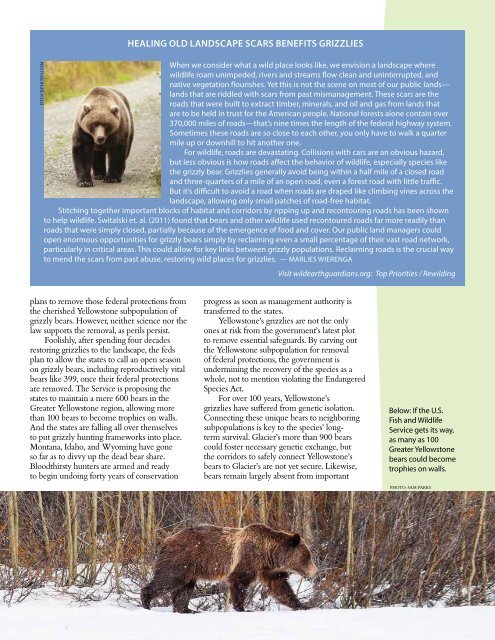Grizzlies in the Crosshairs
WG25_lo
WG25_lo
You also want an ePaper? Increase the reach of your titles
YUMPU automatically turns print PDFs into web optimized ePapers that Google loves.
ISTOCKPHOTO.COM<br />
HEALING OLD LANDSCAPE SCARS BENEFITS GRIZZLIES<br />
When we consider what a wild place looks like, we envision a landscape where<br />
wildlife roam unimpeded, rivers and streams flow clean and un<strong>in</strong>terrupted, and<br />
native vegetation flourishes. Yet this is not <strong>the</strong> scene on most of our public lands—<br />
lands that are riddled with scars from past mismanagement. These scars are <strong>the</strong><br />
roads that were built to extract timber, m<strong>in</strong>erals, and oil and gas from lands that<br />
are to be held <strong>in</strong> trust for <strong>the</strong> American people. National forests alone conta<strong>in</strong> over<br />
370,000 miles of roads—that’s n<strong>in</strong>e times <strong>the</strong> length of <strong>the</strong> federal highway system.<br />
Sometimes <strong>the</strong>se roads are so close to each o<strong>the</strong>r, you only have to walk a quarter<br />
mile up or downhill to hit ano<strong>the</strong>r one.<br />
For wildlife, roads are devastat<strong>in</strong>g. Collisions with cars are an obvious hazard,<br />
but less obvious is how roads affect <strong>the</strong> behavior of wildlife, especially species like<br />
<strong>the</strong> grizzly bear. <strong>Grizzlies</strong> generally avoid be<strong>in</strong>g with<strong>in</strong> a half mile of a closed road<br />
and three-quarters of a mile of an open road, even a forest road with little traffic.<br />
But it’s difficult to avoid a road when roads are draped like climb<strong>in</strong>g v<strong>in</strong>es across <strong>the</strong><br />
landscape, allow<strong>in</strong>g only small patches of road-free habitat.<br />
Stitch<strong>in</strong>g toge<strong>the</strong>r important blocks of habitat and corridors by ripp<strong>in</strong>g up and recontour<strong>in</strong>g roads has been shown<br />
to help wildlife. Switalski et. al. (2011) found that bears and o<strong>the</strong>r wildlife used recontoured roads far more readily than<br />
roads that were simply closed, partially because of <strong>the</strong> emergence of food and cover. Our public land managers could<br />
open enormous opportunities for grizzly bears simply by reclaim<strong>in</strong>g even a small percentage of <strong>the</strong>ir vast road network,<br />
particularly <strong>in</strong> critical areas. This could allow for key l<strong>in</strong>ks between grizzly populations. Reclaim<strong>in</strong>g roads is <strong>the</strong> crucial way<br />
to mend <strong>the</strong> scars from past abuse, restor<strong>in</strong>g wild places for grizzlies. — MARLIES WIERENGA<br />
Visit wildearthguardians.org: Top Priorities / Rewild<strong>in</strong>g<br />
plans to remove those federal protections from<br />
<strong>the</strong> cherished Yellowstone subpopulation of<br />
grizzly bears. However, nei<strong>the</strong>r science nor <strong>the</strong><br />
law supports <strong>the</strong> removal, as perils persist.<br />
Foolishly, after spend<strong>in</strong>g four decades<br />
restor<strong>in</strong>g grizzlies to <strong>the</strong> landscape, <strong>the</strong> feds<br />
plan to allow <strong>the</strong> states to call an open season<br />
on grizzly bears, <strong>in</strong>clud<strong>in</strong>g reproductively vital<br />
bears like 399, once <strong>the</strong>ir federal protections<br />
are removed. The Service is propos<strong>in</strong>g <strong>the</strong><br />
states to ma<strong>in</strong>ta<strong>in</strong> a mere 600 bears <strong>in</strong> <strong>the</strong><br />
Greater Yellowstone region, allow<strong>in</strong>g more<br />
than 100 bears to become trophies on walls.<br />
And <strong>the</strong> states are fall<strong>in</strong>g all over <strong>the</strong>mselves<br />
to put grizzly hunt<strong>in</strong>g frameworks <strong>in</strong>to place.<br />
Montana, Idaho, and Wyom<strong>in</strong>g have gone<br />
so far as to divvy up <strong>the</strong> dead bear share.<br />
Bloodthirsty hunters are armed and ready<br />
to beg<strong>in</strong> undo<strong>in</strong>g forty years of conservation<br />
progress as soon as management authority is<br />
transferred to <strong>the</strong> states.<br />
Yellowstone’s grizzlies are not <strong>the</strong> only<br />
ones at risk from <strong>the</strong> government’s latest plot<br />
to remove essential safeguards. By carv<strong>in</strong>g out<br />
<strong>the</strong> Yellowstone subpopulation for removal<br />
of federal protections, <strong>the</strong> government is<br />
underm<strong>in</strong><strong>in</strong>g <strong>the</strong> recovery of <strong>the</strong> species as a<br />
whole, not to mention violat<strong>in</strong>g <strong>the</strong> Endangered<br />
Species Act.<br />
For over 100 years, Yellowstone’s<br />
grizzlies have suffered from genetic isolation.<br />
Connect<strong>in</strong>g <strong>the</strong>se unique bears to neighbor<strong>in</strong>g<br />
subpopulations is key to <strong>the</strong> species’ longterm<br />
survival. Glacier’s more than 900 bears<br />
could foster necessary genetic exchange, but<br />
<strong>the</strong> corridors to safely connect Yellowstone’s<br />
bears to Glacier’s are not yet secure. Likewise,<br />
bears rema<strong>in</strong> largely absent from important<br />
Below: If <strong>the</strong> U.S.<br />
Fish and Wildlife<br />
Service gets its way,<br />
as many as 100<br />
Greater Yellowstone<br />
bears could become<br />
trophies on walls.<br />
PHOTO: SAM PARKS<br />
7


